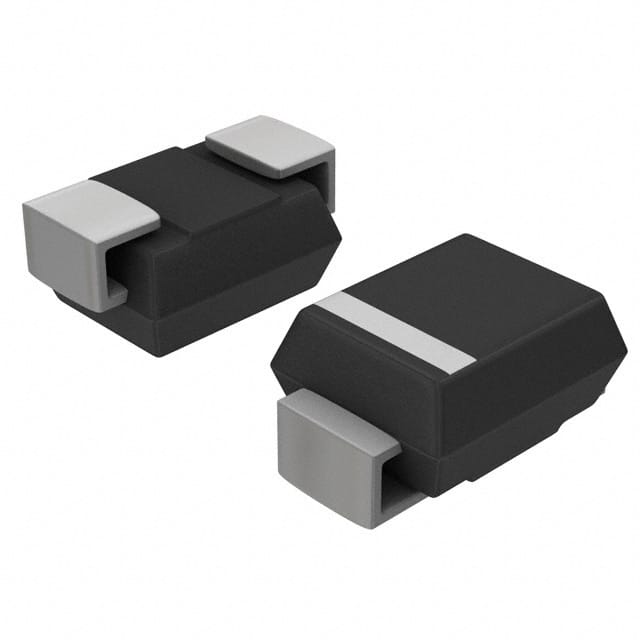SMLJ8.5AE3/TR13
Product Overview
Category
The SMLJ8.5AE3/TR13 belongs to the category of transient voltage suppressor diodes.
Use
These diodes are used to protect sensitive electronic components from voltage spikes and transients.
Characteristics
- Fast response time
- Low clamping voltage
- High surge current capability
Package
The SMLJ8.5AE3/TR13 is typically available in a DO-214AB (SMC) package.
Essence
The essence of this product lies in its ability to divert excessive voltage away from sensitive components, thereby safeguarding them from damage.
Packaging/Quantity
These diodes are commonly packaged in reels or trays, with quantities varying based on manufacturer specifications.
Specifications
- Peak Pulse Power: 3000W
- Breakdown Voltage: 8.5V
- Maximum Clamping Voltage: 14.5V
- Operating Temperature Range: -55°C to 150°C
Detailed Pin Configuration
The SMLJ8.5AE3/TR13 follows a standard diode pin configuration, with anode and cathode terminals clearly marked on the package.
Functional Features
- Rapid response to transient overvoltage events
- Low leakage current
- Robust construction for reliability
Advantages
- Effective protection against voltage surges
- Wide operating temperature range
- Compact form factor
Disadvantages
- Limited breakdown voltage compared to higher-rated diodes
- Higher clamping voltage than some specialized diodes
Working Principles
When a voltage spike occurs, the SMLJ8.5AE3/TR13 conducts excess current to ground, limiting the voltage across the protected circuit.
Detailed Application Field Plans
These diodes find extensive use in various applications, including: - Power supplies - Telecommunications equipment - Automotive electronics - Industrial control systems
Detailed and Complete Alternative Models
- P6SMB8.5A
- 1.5KE8.5A
- SMBJ8.5A
In conclusion, the SMLJ8.5AE3/TR13 transient voltage suppressor diode offers reliable protection against voltage transients in a wide range of electronic applications, making it an essential component for ensuring the longevity and reliability of sensitive electronic circuits.
10个与SMLJ8.5AE3/TR13在技术解决方案中的应用相关的常见问题及解答
What is SMLJ8.5AE3/TR13?
- SMLJ8.5AE3/TR13 is a transient voltage suppressor diode designed to protect sensitive electronics from voltage spikes and transients.
What is the maximum working voltage of SMLJ8.5AE3/TR13?
- The maximum working voltage of SMLJ8.5AE3/TR13 is 8.5V.
What is the peak pulse current rating of SMLJ8.5AE3/TR13?
- The peak pulse current rating of SMLJ8.5AE3/TR13 is typically 300A.
How does SMLJ8.5AE3/TR13 protect electronic circuits?
- SMLJ8.5AE3/TR13 clamps the voltage during transient events, diverting excess current away from sensitive components, thus protecting them from damage.
In what type of applications can SMLJ8.5AE3/TR13 be used?
- SMLJ8.5AE3/TR13 can be used in various applications such as power supplies, automotive electronics, telecommunications equipment, and industrial controls.
What is the response time of SMLJ8.5AE3/TR13?
- The response time of SMLJ8.5AE3/TR13 is very fast, typically responding within nanoseconds to transient voltage events.
Can SMLJ8.5AE3/TR13 be used for surge protection in AC power lines?
- Yes, SMLJ8.5AE3/TR13 can be used for surge protection in AC power lines, especially in low-voltage applications.
What are the temperature specifications for SMLJ8.5AE3/TR13?
- SMLJ8.5AE3/TR13 has an operating temperature range of -55°C to +150°C, making it suitable for a wide range of environments.
Does SMLJ8.5AE3/TR13 require any external components for proper operation?
- SMLJ8.5AE3/TR13 does not require any external components for basic operation, but appropriate circuit design and layout considerations are recommended for optimal performance.
Is SMLJ8.5AE3/TR13 RoHS compliant?
- Yes, SMLJ8.5AE3/TR13 is RoHS compliant, meeting the requirements for lead-free and environmentally friendly manufacturing processes.


